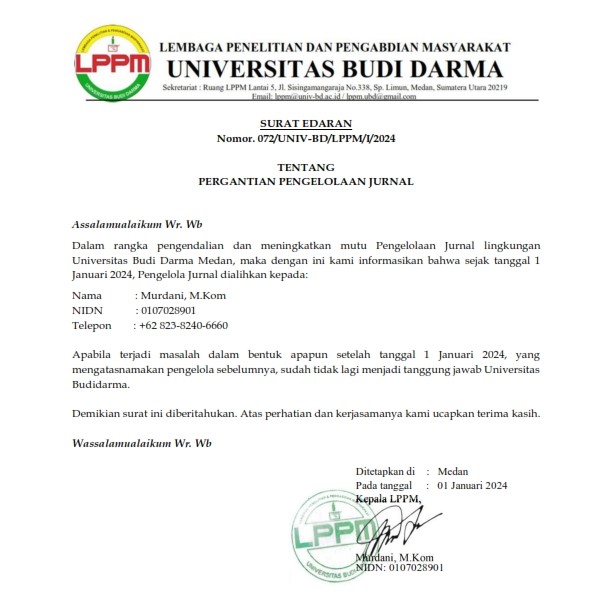Optimasi Pengendalian Suhu dan Kelembapan Ruangan di Kota Yogyakarta Menggunakan Metode Fuzzy
DOI:
https://doi.org/10.30865/jurikom.v9i6.5060Keywords:
Duty Cycle, Fuzzy Tsukamoto, Fan Speed, Temperature Control, Optimization System, Control SystemAbstract
The dry season is a season where most regions in Indonesia experience an increase in temperature. This unstable temperature can have a negative effect on the human body, so a control device is needed according to the needs of the body automatically. This study focuses on optimizing room temperature and humidity control in Yogyakarta City using a fan duty cycle unit with the Fuzzy Tsukamoto method. The ideal temperature and humidity range is obtained from measurements by the Indonesian Board of Meteorology, Climatology, and Geophysics (BMKG). The purpose of this study is to reduce the hot temperature in the room to normal temperature conditions. The calculation results with a temperature of 28.29°C and humidity of 79.06% resulted in a duty cycle of 40.92%. Based on 50 sample data taken each fan rotated for five minutes showed that the average change in temperature was -0.01°C and humidity -0.032%, meaning it could lower 0.01°C and humidity 0.032% every five minutes. This result is considered inefficient considering the very small changes, so in subsequent studies it is recommended to use technology such as air conditioning as a control toolReferences
REFERENCES
A. Efendi, A. Nugraha, and R. Baharta, “Manufacturing of electrical dryer machine for food and fruit products,†IOP Conf. Ser. Mater. Sci. Eng., vol. 692, no. 1, 2019, doi: 10.1088/1757-899X/692/1/012006.
H. Feriadi and N. H. Wong, “Thermal comfort for naturally ventilated houses in Indonesia,†Energy Build., vol. 36, no. 7, pp. 614–626, 2004, doi: 10.1016/j.enbuild.2004.01.011.
J. H. Huh and M. J. Brandemuehl, “Optimization of air-conditioning system operating strategies for hot and humid climates,†Energy Build., vol. 40, no. 7, pp. 1202–1213, 2008, doi: 10.1016/j.enbuild.2007.10.018.
O. Jay et al., “Reducing the health effects of hot weather and heat extremes: from personal cooling strategies to green cities,†Lancet, vol. 398, no. 10301, pp. 709–724, 2021, doi: 10.1016/S0140-6736(21)01209-5.
B. Morabito et al., “Multi-stage Event-triggered Model Predictive Control for Automated Trajectory Drilling,†IFAC-PapersOnLine, vol. 53, pp. 9478–9483, 2020, doi: 10.1016/j.ifacol.2020.12.2421.
H. Zahid, O. Elmansoury, and R. Yaagoubi, “Dynamic Predicted Mean Vote: An IoT-BIM integrated approach for indoor thermal comfort optimization,†Autom. Constr., vol. 129, no. June, p. 103805, 2021, doi: 10.1016/j.autcon.2021.103805.
P. Wolkoff, K. Azuma, and P. Carrer, “Health, work performance, and risk of infection in office-like environments: The role of indoor temperature, air humidity, and ventilation,†Int. J. Hyg. Environ. Health, vol. 233, no. September 2020, p. 113709, 2021, doi: 10.1016/j.ijheh.2021.113709.
F. N. Sabri, M. Mukhidin, Y. S. Disastra, and B. Hasan, “Manufacture and working procedure of Temperature Control Unit (TCU),†IOP Conf. Ser. Mater. Sci. Eng., vol. 1098, no. 4, p. 042060, 2021, doi: 10.1088/1757-899x/1098/4/042060.
A. F. Subahi, “An Intelligent IoT-Based System Design for Controlling and Monitoring Greenhouse Temperature,†IEEE Access., vol. 8, 2020, doi: 10.1109/ACCESS.2020.3007955.
M. O. Onibonoje, “An IoT-Based Approach to Real-Time Conditioning and Control in a Server Room,†2019 Int. Artif. Intell. Data Process. Symp., pp. 1–6.
R. Rakhmawati, Irianto, F. D. Murdianto, A. Luthfi, and A. Y. Rahman, “Thermal optimization on incubator using fuzzy inference system based IoT,†Proceeding - 2019 Int. Conf. Artif. Intell. Inf. Technol. ICAIIT 2019, pp. 464–468, 2019, doi: 10.1109/ICAIIT.2019.8834530.
E. Science, “Optimization of electrical energy in the fan using fuzzy logic controllers,â€. International Conference on Environmental, Energy and Earth Science., 2022, doi: 10.1088/1755-1315/1041/1/012025.
F. H. Purwanto and E. Utami, “Design of Server Room Temperature and Humidity Control System using Fuzzy Logic Based on Microcontroller,â€. 2018 International Conference on Information and Communications Technology (ICOIACT)., pp. 390–395, 2018.
E. Susanto and W. S. Pambudi, “Rancang Bangun Prototipe Sistem Monitoring Suhu dan Kelembaban Gudang Berbasis Scada,â€. Jurnal Riset Komputer., vol. 8, no. 6, pp. 231–236, 2021, doi: 10.30865/jurikom.v8i6.3628.
A. C. Nicolla et al., “Comparison of Damselfly (Odanata: Zygoptera) diversity in wet dune slack habitat with canopied and non-canopied areas of Gumuk Pasir Parangkusumo, Yogyakarta, Indonesia,†IOP Conf. Ser. Earth Environ. Sci., vol. 736, no. 1, 2021, doi: 10.1088/1755-1315/736/1/012046.
P. Wellyantama and S. Soekirno, “Temperature, pressure, relative humidity and rainfall sensors early error detection system for automatic weather station (AWS) with artificial neural network (ANN) backpropagation,†J. Phys. Conf. Ser., vol. 1816, no. 1, 2021, doi: 10.1088/1742-6596/1816/1/012056.
M. Alvan Prastoyo Utomo, A. Aziz, Winarno, and B. Harjito, “Server Room Temperature & Humidity Monitoring Based on Internet of Thing (IoT),†J. Phys. Conf. Ser., vol. 1306, no. 1, pp. 0–8, 2019, doi: 10.1088/1742-6596/1306/1/012030.
A. Yudhana et al., “Multi sensor application-based for measuring the quality of human urine on first-void urine,†Sens. Bio-Sensing Res., vol. 34, no. September, p. 100461, 2021, doi: 10.1016/j.sbsr.2021.100461.
N. H. Wijaya, A. Yudhana, Robiyansah, and D. Sukwono, “X-Ray machine control with wireless based on mA parameters,†IOP Conf. Ser. Mater. Sci. Eng., vol. 1088, no. 1, p. 012080, 2021, doi: 10.1088/1757-899x/1088/1/012080.
A. Yudhana, D. Sulistyo, and I. Mufandi, “GIS-based and Naïve Bayes for nitrogen soil mapping in Lendah, Indonesia,†Sens. Bio-Sensing Res., vol. 33, no. June, p. 100435, 2021, doi: 10.1016/j.sbsr.2021.100435.
A. Yudhana, Sunardi, and Priyatno, “Development of Door Safety Fingerprint Verification using Neural Network,†J. Phys. Conf. Ser., vol. 1373, no. 1, 2019, doi: 10.1088/1742-6596/1373/1/012053.
A. Yudhana, J. Rahmawan, and C. U. P. Negara, “Flex sensors and MPU6050 sensors responses on smart glove for sign language translation,†IOP Conf. Ser. Mater. Sci. Eng., vol. 403, no. 1, 2018, doi: 10.1088/1757-899X/403/1/012032.
O. Barybin, E. Zaitseva, and V. Brazhnyi, “Testing the security ESP32 internet of things devices,†2019 IEEE Int. Sci. Conf. Probl. Infocommunications Sci. Technol. PIC S T 2019 - Proc., pp. 143–146, 2019, doi: 10.1109/PICST47496.2019.9061269.
U. Sakız, G. U. Kaya, and O. Yaralı, “Prediction of drilling rate index from rock strength and cerchar abrasivity index properties using fuzzy inference system,†Arab. J. Geosci., vol. 14, no. 5, 2021, doi: 10.1007/s12517-021-06647-w.
M. M. Gómez, D. Tagle-Zamora, J. L. M. MartÃnez, A. R. C. Ortega, J. de J. M. RodrÃguez, and X. Delgado-Galván, “Water Supply Management Index: Leon, Guanajuato, Mexico,†Water (Switzerland), vol. 14, no. 6, pp. 1–17, 2022, doi: 10.3390/w14060919.
D. Kucuk Matci and U. Avdan, “Optimization-based automated unsupervised classification method: A novel approach,†Expert Syst. Appl., vol. 160, 2020, doi: 10.1016/j.eswa.2020.113735.
M. Omair et al., “The Selection of the Sustainable Suppliers by the Development of a Decision Support Framework Based on Analytical Hierarchical Process and Fuzzy Inference System,†Int. J. Fuzzy Syst., vol. 23, no. 7, pp. 1986–2003, 2021, doi: 10.1007/s40815-021-01073-2.
A. Guzman-urbina, K. Ouchi, H. Ohno, and Y. Fukushima, “FIEMA , a system of fuzzy inference and emission analytics for sustainability-oriented chemical process design,†Appl. Soft Comput., vol. 126, p. 109295, 2022, doi: 10.1016/j.asoc.2022.109295.
S. Napitupulu, E. B. Nababan, and P. Sihombing, “Comparative Analysis of Fuzzy Inference Tsukamoto Mamdani and Sugeno in the Horticulture Export Selling Price,†Mecn. 2020 - Int. Conf. Mech. Electron. Comput. Ind. Technol., pp. 183–187, 2020, doi: 10.1109/MECnIT48290.2020.9166587.
E. Sonalitha, B. Nurdewanto, S. Ratih, N. R. Sari, A. B. Setiawan, and P. Tutuko, “Comparative Analysis of Tsukamoto and Mamdani Fuzzy Inference System on Market Matching to Determine the Number of Exports for MSMEs,†2018 Electr. Power, Electron. Commun. Control. Informatics Semin. EECCIS 2018, pp. 440–445, 2018, doi: 10.1109/EECCIS.2018.8692989.
A. Lipare, D. R. Edla, and S. R. Parne, “Fuzzy rule-based system for energy efficiency in wireless sensor networks,†J. Supercomput., vol. 77, no. 9, pp. 9947–9970, 2021, doi: 10.1007/s11227-021-03668-w.
C. Dumitrescu, P. Ciotirnae, and C. Vizitiu, “Fuzzy logic for intelligent control system using soft computing applications,†Sensors, vol. 21, no. 8, pp. 1–33, 2021, doi: 10.3390/s21082617.
T. Sutikno, A. C. Subrata, and A. Elkhateb, “Evaluation of Fuzzy Membership Function Effects for Maximum Power Point Tracking Technique of Photovoltaic System,†IEEE Access, vol. 9, pp. 109157–109165, 2021, doi: 10.1109/ACCESS.2021.3102050.
S. N. Putri and D. R. S. Saputro, “Construction fuzzy logic with curve shoulder in inference system mamdani,†J. Phys. Conf. Ser., vol. 1776, no. 1, 2021, doi: 10.1088/1742-6596/1776/1/012060.
M. Marbun, W. Ramdhan, D. Priyanto, M. Zarlis, and Z. Nasution, “Philosophy of Fuzzy Logic as Fundamental of Decision Making Based on Rule,†J. Phys. Conf. Ser., vol. 1230, no. 1, 2019, doi: 10.1088/1742-6596/1230/1/012021.
P. G. Singerman, S. M. Orourke, R. M. Narayanan, and M. Rangaswamy, “Language-Based Cost Functions: Another Step Toward a Truly Cognitive Radar,†IEEE Trans. Aerosp. Electron. Syst., vol. 57, no. 6, pp. 3827–3843, 2021, doi: 10.1109/TAES.2021.3082714.
A. P. C. de Sena, I. S. de Freitas, A. C. L. Filho, and C. A. N. Sobrinho, “Fuzzy diagnostics for gearbox failures based on induction motor current and wavelet entropy,†J. Brazilian Soc. Mech. Sci. Eng., vol. 43, no. 5, pp. 1–15, 2021, doi: 10.1007/s40430-021-02964-z.
O. M. Olabanji and K. Mpofu, “Hybridized fuzzy analytic hierarchy process and fuzzy weighted average for identifying optimal design concept,†Heliyon, vol. 6, no. 1, p. e03182, 2020, doi: 10.1016/j.heliyon.2020.e03182.
BMKG, “Data Online Pusat Database BMKG,†www.bmkg.go.id, 2021. https://dataonline.bmkg.go.id/akses_data (accessed Aug. 14, 2022).
A. Gehlot et al., “Internet of things and long-range-based smart lampposts for illuminating smart cities,†Sustain., vol. 13, no. 11, 2021, doi: 10.3390/su13116398.
E. F. Yogachi, V. M. Nasution, and G. Prakarsa, “Design and Development of Fuzzy Logic Application Mamdani Method in Predicting The Number of Covid-19 Positive Cases in West Java,†IOP Conf. Ser. Mater. Sci. Eng., vol. 1115, no. 1, p. 012031, 2021, doi: 10.1088/1757-899x/1115/1/012031.
L. G. Ioannou et al., “The impacts of sun exposure on worker physiology and cognition: Multi-country evidence and interventions,†Int. J. Environ. Res. Public Health, vol. 18, no. 14, 2021, doi: 10.3390/ijerph18147698.
A. H. M. Eldesoky, J. Gil, and M. B. Pont, “The suitability of the urban local climate zone classification scheme for surface temperature studies in distinct macroclimate regions,†Urban Clim., vol. 37, no. March, p. 100823, 2021, doi: 10.1016/j.uclim.2021.100823.
T. H. Karyono, “Predicting comfort temperature in Indonesia, an initial step to reduce cooling energy consumption,†Buildings, vol. 5, no. 3, pp. 802–813, 2015, doi: 10.3390/buildings5030802.
W. Su, B. Yang, B. Zhou, F. Wang, and A. Li, “A novel convection and radiation combined terminal device: Its impact on occupant thermal comfort and cognitive performance in winter indoor environments,†Energy Build., vol. 246, p. 111123, 2021, doi: 10.1016/j.enbuild.2021.111123.
B. Arifin, B. Y. Suprapto, S. A. D. Prasetyowati, and Z. Nawawi, “Steering Control in Electric Power Steering Autonomous Vehicle Using Type-2 Fuzzy Logic Control and PI Control,†World Electr. Veh. J., vol. 13, no. 3, 2022, doi: 10.3390/wevj13030053.
Ž. Šitum and D. Ćorić, “Position Control of a Pneumatic Drive Using a Fuzzy Controller with An Analytic Activation Function,†Sensors, vol. 22, no. 3, 2022, doi: 10.3390/s22031004.
I. Wahyuni, W. F. Mahmudy, and A. Iriany, “Rainfall prediction in Tengger region Indonesia using Tsukamoto fuzzy inference system,†Proc. - 2016 1st Int. Conf. Inf. Technol. Inf. Syst. Electr. Eng. ICITISEE 2016, pp. 130–135, 2016, doi: 10.1109/ICITISEE.2016.7803061.
T. Hastono, A. J. Santoso, and Pranowo, “Honey yield prediction using tsukamoto fuzzy inference system,†Int. Conf. Electr. Eng. Comput. Sci. Informatics, vol. 2017-Decem, no. September, pp. 19–21, 2017, doi: 10.1109/EECSI.2017.8239150.
D. A. N. Wulandari, T. Prihatin, A. Prasetyo, and N. Merlina, “A Comparison Tsukamoto and Mamdani Methods in Fuzzy Inference System for Determining Nutritional Toddlers,†2018 6th Int. Conf. Cyber IT Serv. Manag. CITSM 2018, no. Citsm, pp. 1–7, 2019, doi: 10.1109/CITSM.2018.8674248.
A. Rusmardiana, T. Y. Akhirina, D. Yulistyanti, and U. Pauziah, “A Web-Based High School Major Decision Support System in Banten Using Tsukamoto’s Fuzzy Method,†Proceeding - 2018 Int. Semin. Intell. Technol. Its Appl. ISITIA 2018, pp. 233–238, 2018, doi: 10.1109/ISITIA.2018.8711337.








